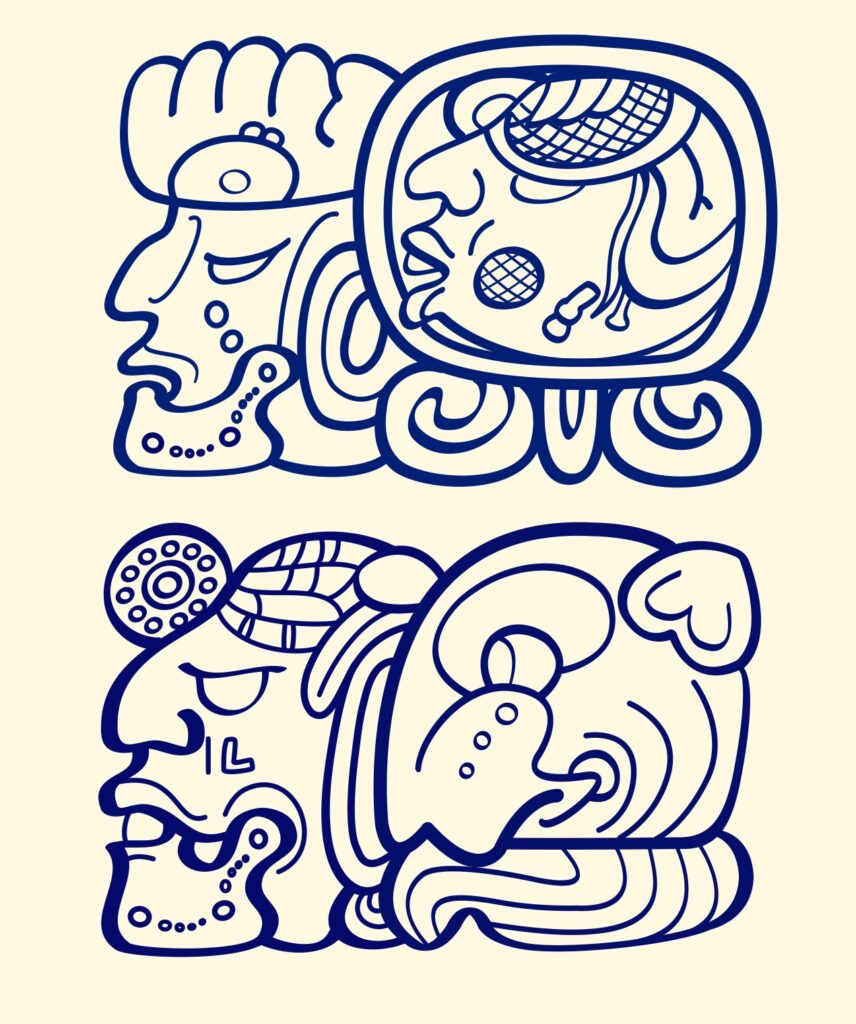
12 Ajaw 3 Xul: Drawing by Jorge Pérez de Lara
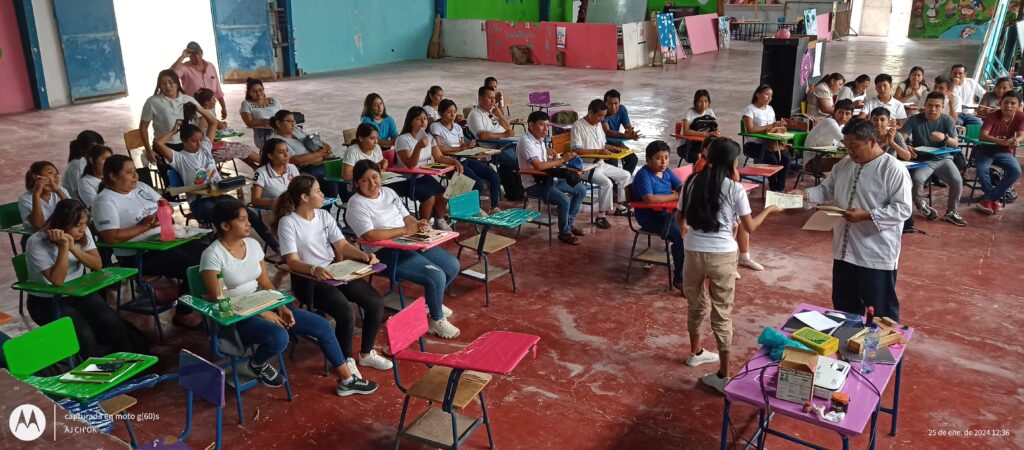
Professor Alfredo Chayax closing the event and
presenting diplomas to participants
This month, we hear back from Aj Xol Ch’ok and Beatriz Par Sapón, who carried out a workshop on Maya writing earlier this year in San José, Petén, Guatemala. This was the first time MAM has had the opportunity to sponsor a workshop for Itza’ Maya speakers and community members. This is especially significant, since Itza’ is one of the most critically endangered of all of the living Mayan languages. Students learned to use the tz’iib’leb’, a traditional cane writing instrument, and the results are a sight to behold!
12 Ajaw 3 Xul (July 11, 2024)
Revitalizing Itza’:
The Maya Script Returns to Ixtutz, San José, Petén
Projects like this that revitalize Maya writing are crucial for the survival of indigenous languages like Itza’ and the knowledge systems that are an integral part of their cultural traditions. We are very proud of helping to support workshops like this, and we thank all of our many supporters for helping to make this possible.
Yus b’o’otik,
Michael Grofe, President
MAM
REPORT
/Reading and Writing Workshop in the Tz’iib’ SystemIxtutz,
San José Petén., January 24 and 25, 2024.
The town of Ixtutz (or municipality of San José), is located 23 kilometers west of the departmental capital of Flores, and approximately 501 kilometers from Guatemala City. This town is located on the northwest side and shore of Lake Itza’, Petén.
The Itza’ Maya people, one of the 22 Maya peoples of Guatemala, are currently located in the municipalities of San Miguel, San Andrés and San José Petén, and according to statistical data from the 2018 Census of the National Institute of Statistics of Guatemala -INE, there are a total of 2,926 Itza’ Maya. However, the speakers of the Itza’ Maya language are currently fewer than 40 people, mostly elderly. Some learned it as their mother tongue and others as a second language, although there are actions by people and state institutions to teach, promote, and use the language in the Itza’ Maya territory of Peten, Guatemala.
On January 24 and 25, 2024, the Uchb’en Tz’iib’ Workshop was held. Thanks to the coordination with Professor José Alfredo Chayax Tesucún, the Directorate of the Institute of Diversified Education and the Itza’ Linguistic Community, as well as the great contribution by Mayas for Ancient Mayan-MAM, it was possible to organize the reading and writing workshop in the Tz’iib’ system. The objective of this workshop was to “strengthen the process of linguistic and cultural revitalization” carried out by different institutions, both national and international, such as: the Academy of Mayan Languages of Guatemala through the Itza’ Linguistic Community, the of Itza’ Language Learning with the support of the University of Toronto, Canada of which Professor Alfredo Chayax is a part, among others as well as its own speakers who fight for the Itza’ language to increase its number of speakers.
FROM THE WORKSHOP ON THE TZ’IIB’ SYSTEM
This workshop was intended to promote Maya knowledge of the Itza’ Maya (speakers and descendants) in San José Petén, Guatemala, due to the condition of the language and the Itza’ people, that both their language and culture are in the process of revitalization and recovery. Therefore, this workshop was contemplated to support the revitalization of Itza’ Maya knowledge, by addressing topics related to the history of ancient knowledge of the Itza’ people, as well as the writing system, to motivate the writing of their Itza’ language, from an artistic and linguistic point of view and thus motivate the spirit of the Itza’ who participate in the workshop and can feed their spirit and identity so that they promote, develop and visualize their language through the Maya writing system.
Forty people participated in the workshop, made up of teachers, language facilitators, students, cultural leaders and speakers of the Itza’ language. Surnames such as Cohuoj, Chablé, Cahuiche, Chan, Tesucún, Chayax, Zacal, Chí, Vitzil, Tut, Zac, Quixchán, Camal, Suntecun, Collí, among others, reflect the permanence of the Itza’ historical identity that was part of this activity.
ACTIVITIES CARRIED OUT
1. Brief description of Maya scientific knowledge and awareness of the importance
of knowing the roots of the culture to strengthen identity.
2. Knowledge and use of the writing system to write words in the Itza’ language.
3. Making reed brushes for writing/painting with the tz’iib’ system.
4. Write words and phrases in the Itza’ language with the tz’iib’ system
5. Exhibition
6. Exercise
7.Presentation of works
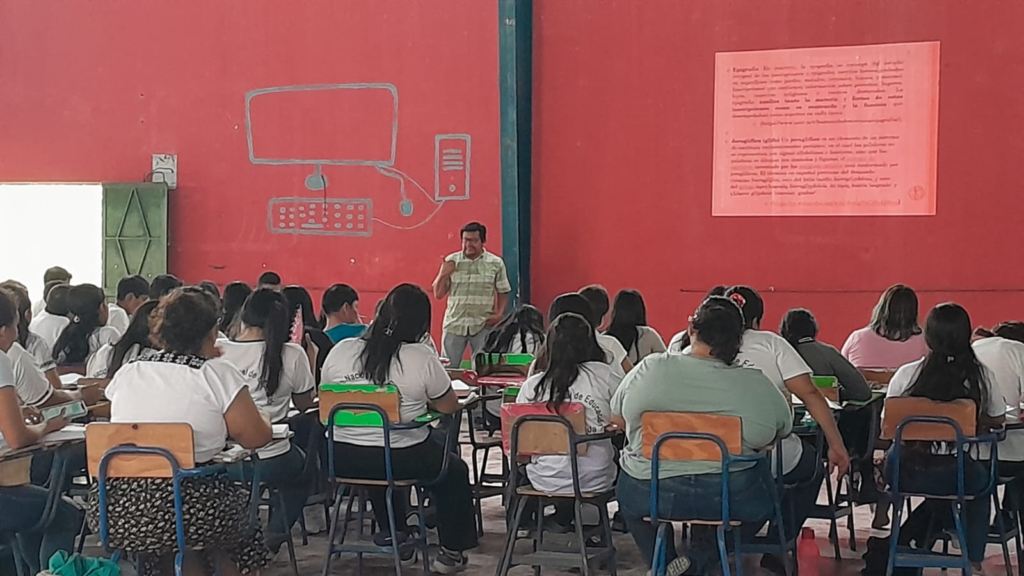
Start of the workshop through an introduction to the topic.

Worksheets to learn the structure of words written with the tz’iib’ system.
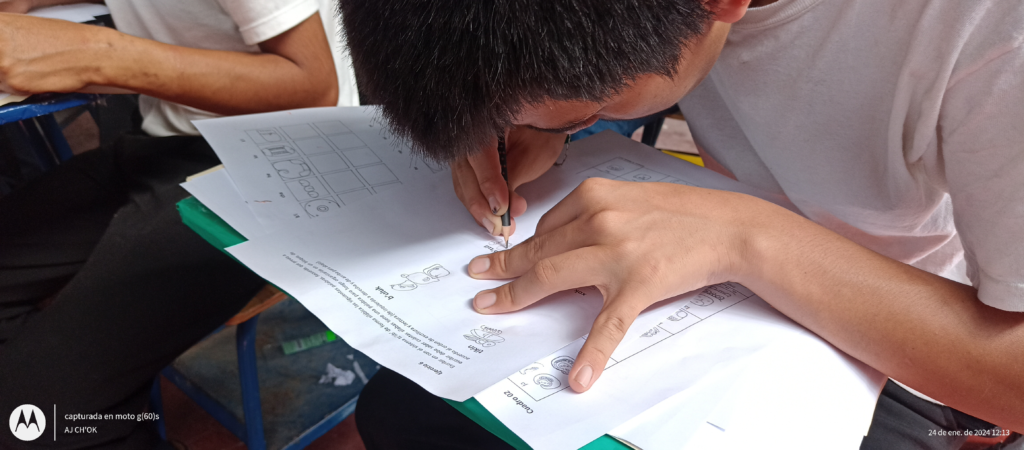
Practicing the use of the tz’iib’ system, writing words in Maya.
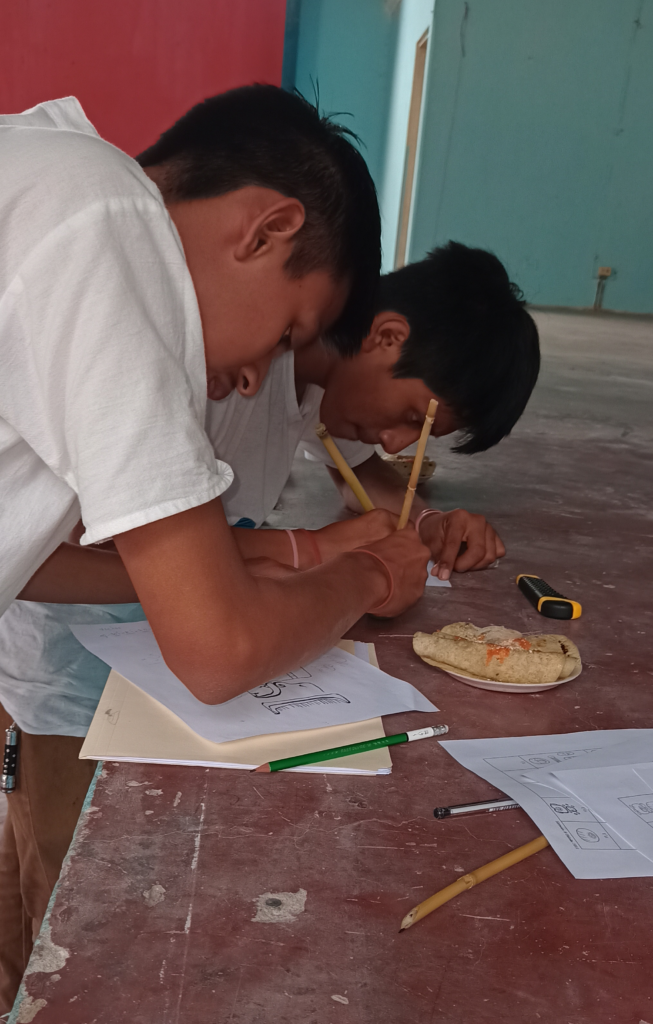
Students practicing the use of the tz’iib’leb’ (writing instrument)
made from cane, writing words in Mayan with Chinese ink.
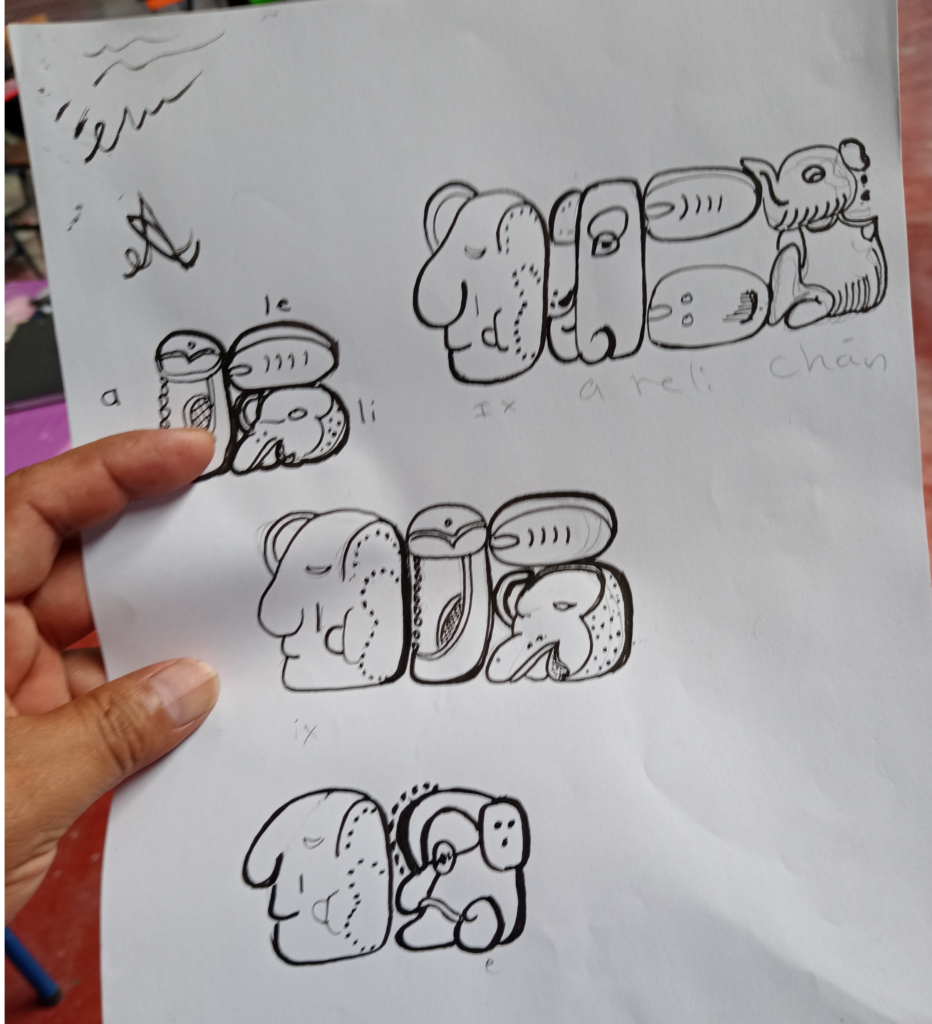
Examples of words written with the tz’iib’leb’
made from cane by Aréli Chan Tesucún.
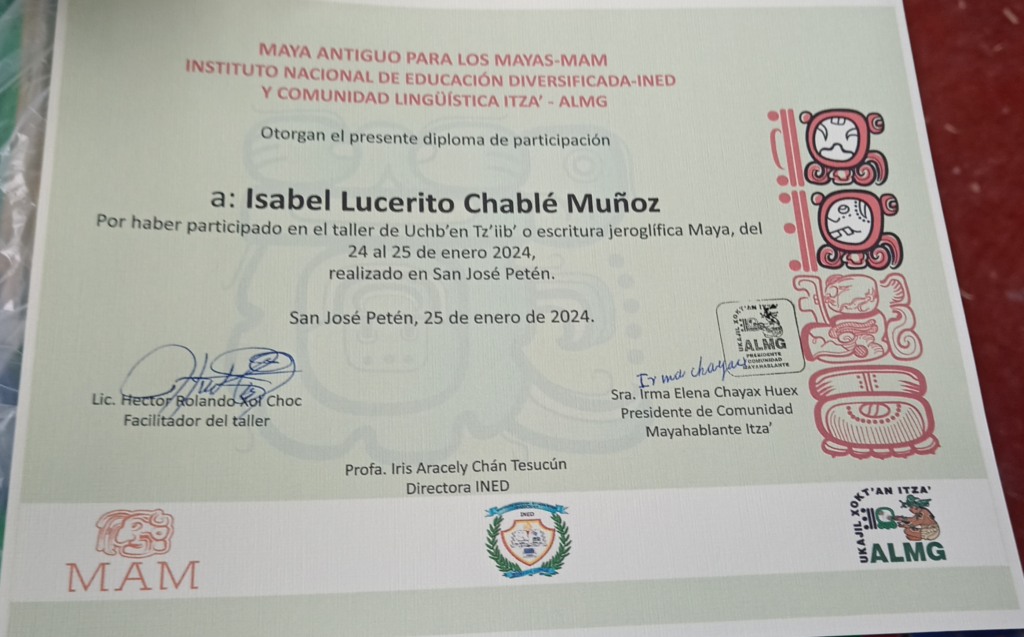
Copy of diploma delivered to participants in the workshop.
RESULTS
Through the workshop held in San José Petén aimed at Itza’ speakers, young students and adults engaged in the process of learning the Itza’ culture and language, as part of the linguistic and cultural revitalization process carried out by Professor José Alfredo Chayax, the Itza’ Linguistic Community and the Institute of Diversified Education -INED. The workshop was carried out satisfactorily, since the objective of strengthening the process of revitalization of the Itza’ language and culture was achieved through learning the use of the Maya tz’iib’ writing system and applying it in writing words and phrases in the Itza’ Maya language.
In addition to having motivated the participants, mostly descendants of the Itza’ Maya people, to value the art of writing of their Maya ancestors who lived in the lands where they currently live and that they can see in ancient cities such as Tikal, Yaxha’, Uaxactun and other places in Petén.
FOLLOW-UP
It is important to continue this process to strengthen the learning of ancient Maya literature, as well as the use of the tz’iib’ system to write the Itza’ language of today. Coordination will continue with institutions that promote Maya culture and language in San José Petén, as well as maintaining the support of MAM.
ACKNOWLEDGEMENTS
To Professor José Alfredo Chayax for his great support and his work in the promotion and use of the Mayan language, to the management of the Institute of Diversified National Education-INED, to the Itza’ Linguistic Community for providing us with the diplomas for the event and the participation of its technical team and Maya Antiguo para los Mayas-MAM for providing the financial resources to develop this workshop.
By
Aj Xol Ch’ok, Hector R.
Beatriz Par Sapon

